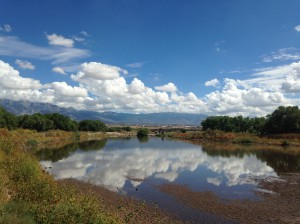DBS&A Presenting on Watershed Based MS4 Permit at Texas Water 2018
 Hydrologist Stephanie J. Moore, P.G., will present on Collaboration for the Albuquerque Municipal Separate Storm Sewer System (MS4) Watershed Based Permit at Texas Water 2018 from April 24-26, 2018, in San Antonio. DBS&A Engineer Jennifer Hill, P.E., and DBS&A Hydrogeologist Chad Johannesen, P.G., are co-authors of the presentation. Click here to learn about DBS&A’s stormwater management expertise.
Hydrologist Stephanie J. Moore, P.G., will present on Collaboration for the Albuquerque Municipal Separate Storm Sewer System (MS4) Watershed Based Permit at Texas Water 2018 from April 24-26, 2018, in San Antonio. DBS&A Engineer Jennifer Hill, P.E., and DBS&A Hydrogeologist Chad Johannesen, P.G., are co-authors of the presentation. Click here to learn about DBS&A’s stormwater management expertise.
Texas Water 2018 is the largest regional water conference in North America. The conference is a joint effort of the Texas Section of the American Water Works Association (AWWA) and the Water Environment Association (WEA) of Texas. Click here for more information about the conference.
Collaboration and the Albuquerque MS4 Watershed Based Permit presented by Stephanie Moore, P.G.
The U.S. Environmental Protection Agency’s (EPA) MS4 Stormwater Program is intended to improve the Nation’s waterways by reducing the quantity of pollutants transported into receiving bodies of water during storm events. Common pollutants include oils and grease from roadways, herbicides and pesticides from landscaping runoff, and sediment from construction sites. When deposited into nearby waterways, these pollutants can impair the waterways, discouraging recreational use of the resource, contaminating drinking water supplies, and degrading with wildlife habitat.
The watershed based permit encourages collaboration between co-permittees by reducing monitoring requirements and extending permit deadlines for organizations that collaborate. Collaboration can either occur on limited conditions of the permit, or on many, or all conditions of the permit. Collaboration can be between two parties or multiple parties on the permit. For the Middle Rio Grande watershed, 12 of the 17 co-permittees are currently collaborating on the required water quality monitoring. This collaboration dramatically reduces the number of monitoring locations, and the monitoring program costs.
The Phase 1 National Pollutant Discharge Elimination System (NPDES) stormwater program, promulgated in 1990, requiring operators of medium and large MS4s (generally communities with populations >100,000), to implement stormwater management programs. The Phase II rule extends coverage of the NPDES program to certain “small” MS4s. The Phase II rule automatically covers all small MS4 located in urbanized areas (UA’s) as well as small MS4 communities located outside of UA’s that the NPDES permitting authority designates on a case-by-case basis.
There are six program elements of the MS4 program: 1) public education and outreach, 2) public participation/involvement, 3) illicit discharge detection and elimination, 4) construction site runoff control, 5) post-construction runoff control, and 6) pollution prevention/good housekeeping.
The Middle Rio Grande watershed was one of three areas nation-wide to receive a permit under EPA’ s pilot program. The other areas include Ramsey Washington Watershed District in Minnesota, and Milwaukee Metro Watershed in Wisconsin. The Middle Rio Grande watershed has 17 co-permittees, including municipalities (small and large), two counties, the University of New Mexico, two flood control districts, three Native American tribes, the State fairgrounds, and Sandia National Laboratory.
This presentation will provide an overview of the MS4 watershed based permitting program, and give examples from the Middle Rio Grande watershed Phase I and Phase II projects, highlighting the collaborative efforts being used to meet the permit conditions.
